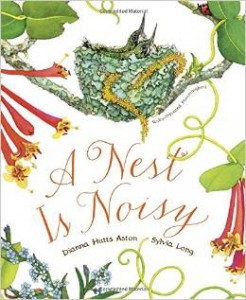 Families come in such diverse variety. As adoptive families we search for opportunities to highlight this range of difference in a way that equates with “interesting” instead of odd or abnormal. Diana Hutts Aston’s fascinating book, A Nest Is Noisy delves into the natural world to depict some of the many wonderful ways that animals prepare to house and protect their young. Illustrated with exquisite detail by Sylvia Long, the book is a feast for the eyes as well as a smorgasbord of interesting information.
Families come in such diverse variety. As adoptive families we search for opportunities to highlight this range of difference in a way that equates with “interesting” instead of odd or abnormal. Diana Hutts Aston’s fascinating book, A Nest Is Noisy delves into the natural world to depict some of the many wonderful ways that animals prepare to house and protect their young. Illustrated with exquisite detail by Sylvia Long, the book is a feast for the eyes as well as a smorgasbord of interesting information.
The illustrations add depth and interest. Children can spend a great deal of time studying them for hidden details. They’ll enjoy a game of “I Spy” if they are challenged to look for tiny details. Readers will see the many commonalities as well as differences in how various animals prepare for parenthood. After reading the book, challenge your child to look for nests in his neighborhood.
Readers learn about nests: the biggest and smallest, nests built in trees and on the ground, constructed underground and created underwater. It features birds, fish, and snakes, bees, frogs and alligators, turtles, ants and platypuses. Kids will find a favorite among the crowd. They’ll enjoy learning about all the different ways animal parents prepare for the arrival of their offspring.
The AQ* Lens: A Nest Is Noisy even features two varieties of birds that lay their eggs in a nest and then allow others to nurture and raise them. This offers a chance to segue into a discussion of how some animal parents are not able to nurture and raise their babies. Instead, these birds carefully choose a nest where their little ones will receive the care they need and deserve. The book identifies one nest as “adopted.”
Tread lightly, if you choose to connect this thread to human parents making an adoption plan. (It is an easy tack to take.) Just remember to speak with respect and empathy for birthparents. Highlight the care with which they identified a new “nest” for their child. Explain that adult reasons and adult shortcomings necessitated an adoption. Make it clear that it was not the baby’s fault or due to any shortcomings on the child’s part. Ask your child what he thinks the animal might be feeling. (This may give you some insight to his own feelings about adoption loss.) Come from curiosity so that you allow them to express genuine feelings and not deliver what they think you want to hear.
A Nest Is Noisy is a beautiful book, chock full of information.I rate it as

